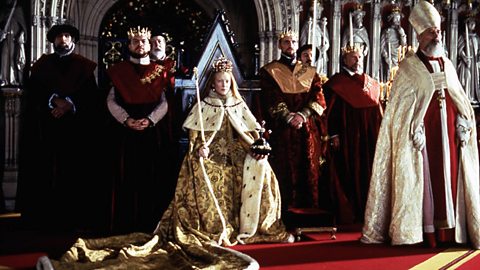Considering colour, condition, cut, fabric and fit
When designing a costume, there are several aspects to consider, including:
- colour
- condition
- cut
- fabric
- fit
Colour
Colour is a very important aspect of a costume. It can convey a symbolicA symbol can represent an abstract idea, eg the colour red representing romance or a dove representing peace. idea or reveal something about the character wearing the costume.
Colour can also be used to help the audience see the similarities or differences between characters. For example, where two families are feuding, the performers may be dressed in different colours to help the audience differentiate. It is important to remember that colours change under stage lighting, eg a white dress will appear blue under a blue light.
Condition
The condition of the costume can convey information about a character's circumstances. For example, a Victorian street beggar leading a hard life may wear dirty rags with holes to show wear and tear, and may also have make-up to appear dirty with missing teeth, cuts and bruises.

Cut
The way a costume is cut refers to the shape of fabric pieces used to construct it. For example, a suit can be cut in different ways to help change the performer’s physical appearance, making them appear either smaller or larger. Cut can also provide information about the historical setting of the play, eg flares are a style of trousers that become wider below the knee and are largely associated with the 1970s.
Fabric
The most appropriate fabrics to suit the character, setting and style of the production should be considered. For example, in the present day performers can wear costumes that use modern synthetic materials, such as nylon. Fabric can also provide information about a character’s social status, eg a wealthy character may wear a silk dress.

Fit
The fit of a costume refers to how the clothing fits the performer, eg tight, oversized or fitted perfectly. It can reveal a character’s personality or the context of the play. A woman in a period drama may wear a very tightly fitted corset to help reflect the historical context of a play, as it was fashionable to accentuate a woman’s physical form.